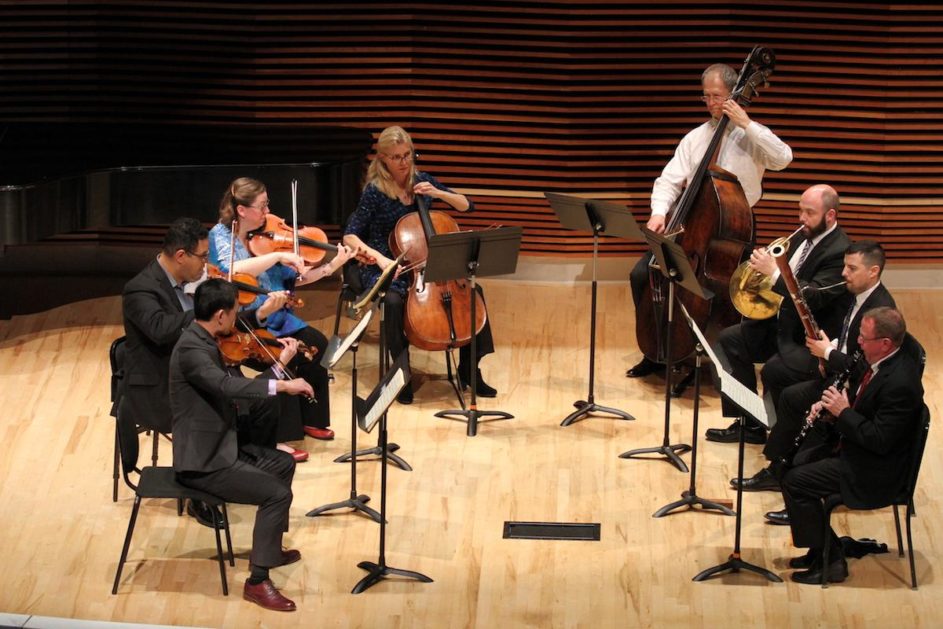At Sunday afternoon’s KSO Chamber Classics concert featuring principal winds and strings, at the Sandra G. Powell Recital Hall at UT’s School of Music, the numbers of musicians in each ensemble grew from three to four to eight. But the quality of the performances soared in each of the three works on the program.

Violinist Gordon Tsao, flutist Hannah Hammel and pianist Emi Kawaga play “Médailles Antiques.”
KSO principal flute Hannah Hammel, associate concertmaster Gordon Tsai and pianist Emi Kawaga began the concert with French flutist and composer Philippe Gaubert’s “Médailles Antiques,” written in 1916.
One of France’s most prominent musicians during the years between the world wars, Gaubert’s clearly French sensitivity to the sound of the flute was wonderfully suited to Hammel’s lovely playing, with the violin and piano playing largely supporting roles.
But Tsai’s intuitive playing of the violin and Kawaga’s crisp piano playing, which always has clarity, held their own.
The piece’s movements, “Nymphes à la Fountaine” (“Nymphs in a Fountain”) and “Danses,” clearly describe the light, playful nature of the piece, with Hammel’s flute playing the role of the mythological spirit of nature splashing in the water and dancing in the woods.

Violinist Edward Pulgar, violist Kathryn Gawne, cellist Stacy Nickell and flutist Claire Chenette play Mozart’s “Oboe Quartet in F Major.”
Then principal oboe Claire Chenette took advantage of her chance to shine in Mozart’s “Oboe Quartet in F Major,” K. 370, written in 1781 for the oboe virtuoso Friedrich Ramm.
Joined by principal second violin Edward Pulgar, principal viola Kathryn Gawne and cellist Stacy Nickell, superbly sitting in for principal cello Andy Bryenton, Chenette was easily the master of the floating lines Mozart wrote at top of the oboe’s range where musicians of the day weren’t used to playing.
During her remarks before beginning the piece, Chenette noted that it is thought that Mozart wrote the high notes as a kind of joke on Ramm to see who could outdo whom as the musical star.
In this performance it was Chenette who easily met Mozart’s challenge, especially in the second movement’s demand for bright, crisp playing at the top of the oboe’s voice. The third movement featured dancing, skipping phrases, along with twirling, sprightly lines that were pure joy to listen to.
The second half of the program was Franz Schubert’s monumental, hour-long “Octet in F Major,” D. 803, written in 1824 as a kind of response to Beethoven’s immensely popular “Septet in E Flat Major,” Op. 20, written 24 years earlier.
Also structuring his composition in six movements, but not wanting to merely copy Beethoven, whom he greatly admired, Schubert added a second violin and an additional 10 minutes or so of music in a work commissioned for Archduke Rudolph, an accomplished clarinet player.
In this performance, KSO principal clarinet Gary Sperl’s gorgeous playing, especially in the prayer-like solo that opens the second movement, marked “Adagio,” set the tone of the music, which never lagged, despite the piece’s length.
In addition to great clarinet playing, Schubert expects an equally great horn player whose accuracy at pianissimo levels is critical to drowning out the violins. Principal horn Jeffery Whaley’s glowing tone, especially when laying out the terrain over which the violins played, was soul-satisfying.
The third wind instrument, played beautifully by principal bassoon Aaron Apaza, added its gnarly voice.
Joining the string instruments of violinists Tsai and Pulgar, violist Gawne and cellist Nickell, principal bass player Steve Benne kept the foundation of the piece firmly anchored.
There were engaging conversations between Nickell’s cello and Tsai’s violin in the middle two movements and at times dueling violins. In the fourth movement’s variations everyone got their turn with appealing solos, with the cello playing little dancing phrases.
In the sixth and final movement, the cello stirs up a storm, with the viola jumping in before the piece comes to a turbulent finish to brilliant playing by everyone.
Concertgoers will have another opportunity to hear these gifted musicians at this week’s Concertmaster Series, William Shaub and Friends, 7 p.m. Wednesday and Thursday at the Knoxville Museum of Art.
Any remaining tickets may be purchased by calling the KSO box office at 865-291-3310 or online.

